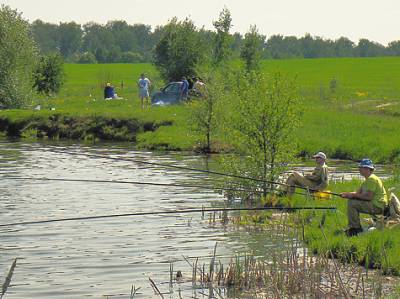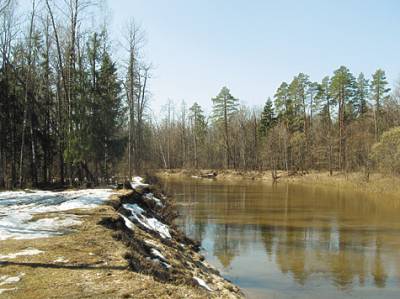
Came the warm days of summer, which is traditionally characterized as a time of backlava. Clarify — backlava those who catches on, perhaps, the habit of using insufficiently sensitive equipment and tooling. Today I again return to the question of the sensitivity of the floats, specifically to their antennas.
It should be clarified what is meant by a functional whole antenna protruding above the water part of the float. The structural antenna is a continuation of the body of the float in the form of more of a thin rod of different materials. On this rod there may be additional elements in the form of bumps or balls. In most cases, the structural antenna coincides with the functional and at the same time say that the float agregen “right.” Actually, to argue the latter is possible only from the point of view of designers in the float, created under the specific conditions of fishing, equipment and ogruzka.
Depending on the fishing conditions, which often do not coincide with the assumptions of the designers, the correct functional okrujenie does not coincide with the correct construction. This is reflected in the fact that the fishing conditions have float nadograditi, that is, except the construction of the antenna above the water is also part of the body of the float. Or, on the contrary, often have to overload the float so that the water from “sticking” only the structural part of the antenna. Strictly speaking, if you have to supercharge or nedogruza the float on the fishing conditions, this indicates that the float in this case is chosen not correctly.
No need to try to make the float a universal and irreplaceable, loved and no matter how “experienced” he was. Perhaps, after all, should benefit from the experience of other anglers and pick up this float, which would, in the circumstances, to work effectively with the right okrujenii that is under the structural antenna.
For those who want to learn to fish in the most uncool days, I propose to understand, in what sense. Okrujenie float under the antenna itself serves a purpose only to achieve the desired sensitivity of the whole equipment. Here there is a direct relationship between thickness and load capacity of the antenna with the weight of the lure. As an example, I invite anyone who wishes to take three float with a different capacity (maybe easier to say, buoyancy) antennas and use different bait on the hook.
In the case of bloodworms or maggots, which have almost zero buoyancy, the difference in okrujenii float depending on the size of the lure will be almost invisible. Clearly the difference is visible if the hook stick to canned corn. If you attach the hook successively one, two and three grains, the float with a thin “sport” antenna just drown, and in the case of a thick antenna, which serves as a continuation of the body of float is balsa wood or foam, the difference will be obvious only in the case of three or four grains of corn.
It would be possible to conclude that the heavier the lure, the thicker the desired antenna. The conclusion is wrong for catching careful and well-fed fish.
For example, when I catch a carp from the bottom of the plug or rod bearing set, provided that the weather is calm and the depth is small, then use the floats with thin and long antenna. Installation of descent by using the depth gauge gives accuracy of a few centimeters due to the soft silt. After the installation of the primary descent I baited with corn, and if the float starts to sink, then add a foot down until the lure is lying on the bottom. Very accurately and conveniently. The sensitivity of this snap-in is so high that you have to hold back and not to strike at the slightest movement of the float. In calm weather broke this customization for efficiency unsurpassed. If a wave, then one bait for anchoring a snap-in will not be enough, and I put on the bottom of the basic sliding sinker. Here it was convenient, olives tungsten alloy. Olive is chosen so that in addition to her ogruzka was still only one little shepherd boy, who serves the lower stopper olives. That is ogruzka together in one point. When you strike the shepherd boy has minimal resistance.
If you go the traditional way or when the excitement becomes such that to observe a thin antenna would be difficult, the angler selects a float with a thick antenna. The most important thing here is that almost always the choice of stops on excessively thick antenna. Sensitivity to bites because of the large buoyancy of the antenna falls so that the float snap-in, beginning to give well-built bottom gear. It should be borne in mind that the closer the snap-in is located to the shore the bite careful, and eventually creates a situation where bottom gear catch, and float there.
Another case is now over. Almost always, especially if the current is sufficiently powerful, the more able to slow down passing snap, the more likely a confident bite. Strong currents very rarely “equal”, and to ensure that the float is not pulled underwater during the free sailing, usually choose designs with floating and thick antenna. This is especially justified when the depth is small. In such cases, I even use floats balls without keels and antennas. But it’s good when a snap is started up in free swimming.
But do not take the fish to swim, and need to make primerica or oderico, and then float “get out” of the water. In fact the sensitivity of snap to the bite does not change, but watch careful bite on the float with a thick antenna and at least a thick part of the body out of the water, it becomes very difficult. If the antenna is thin, you can choose a design, in which the upper body of the float is thin enough. For example, the top body thickness is comparable or even thinner than the thick antenna on the other float. Watch the bites becomes much easier. When I catch technique with a constant oldergay snap, and do not have a plug, I deliberately overload a float with a thin antenna, and the number of invisible bites negated.
Why all this conversation. And the fact that many anglers remain without a decent catch in a good place, with good and well used bait and good tackle just because of the fact that see no bites. And the reason is clearly visible antenna. If we leave aside the classic case of “uploading” bream longest float, then in all cases should strive to use floats with a minimum diameter and a capacity of antennas. But I did notice this, so no need to go to extremes. Antenna need such, what is needed in these conditions. This applies not only to diameter and length. By the way, about the length. Too long an antenna only has meaning in an absolute calm and if you get tired of the constant Solisti fishing line for the antenna in the case of the float with two attachment points. I emphasize two points.
Important painting of the antenna. Here everything is simple. If the background of dark water, the antenna bright yellow. If the sun shines into the eyes, antenna black. Orange color the most versatile, but it is often not visible to the careful peretaplivanii float when the roach or carp try the Frother. A good way is to use removable antennas and the application of waterproof markers. The bad colouring is, from the point of view of the observation of careful bites, this striped antenna. Stripes are blurred, merging, and monitoring of small movements resulting in a strong tension to the eyes. The only advantage of floats with a striped, long and thick antennas — good marketability. But this “advantage” in the eyes of melts, as evidenced by sales statistics of large wholesale firms. There is one exception — herabuna with striped but thin antennas, but that’s a separate issue.
I do not want to abandon classical designs, and to pick up the float not only in appearance but also in terms Rylance. To treat the usual tackle creatively and make necessary adjustments.








